Menu
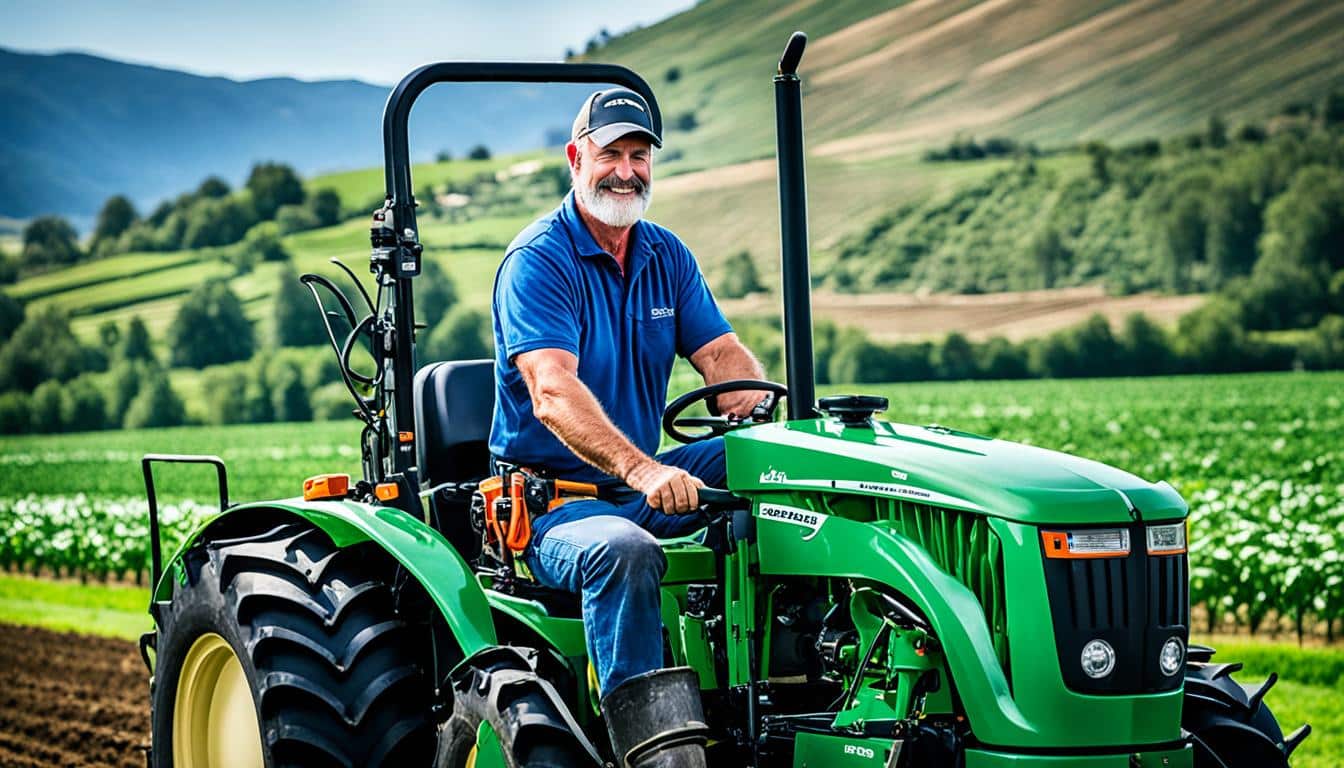
Back injuries in California’s agriculture sector alone could cost over $22 million a year in workers’ compensation. This is mainly because farm workers often get backaches. They also experience pain in their shoulders, arms, and hands. This happens because farming tasks are tough. The National Institute for Occupational Safety and Health says these health issues are too common.
Ergonomics helps keep farmers healthy. It makes sure that work methods and tools fit well with the human body. This can help reduce aches and pains. Using ergonomic approaches not only keeps farm workers healthy. It also increases how much work gets done. And, it lowers future costs related to health. For example, making loads lighter and using totes with handles can reduce pain by up to 20%. This change doesn’t affect how much work is done.
It’s important to keep tools close, like within 17 inches of the body. Plus, using mats can reduce tiredness from standing on hard floors. These are simple but effective ways to improve health. They prevent injuries and make work safer for farmers.
Ergonomics plays a vital role in keeping farm work safe and efficient. It adjusts the work environment to suit the physical strengths and limits of workers. This helps lower the risk of injuries and boosts how much work gets done.
Being safe and efficient at work is the goal of ergonomics. It looks at how the job impacts the worker’s body. Then, it finds ways to make the work less harmful.
Set up ergonomically, farms see fewer injuries like back pain and sore arms. These problems often come from overusing the body. And they’re the top reason people can’t work during their working life.
Repeating the same movement over and over, standing in odd ways, and using badly designed tools cause a lot of issues. Tips to help include keeping tools close, making sure seated jobs are available, and using tools that fit the hand well.
Also, lifting items in a way that’s easier on the body can prevent injuries. Using devices like dollies or carts for heavy things and minimizing vibrations are key. These steps keep workers healthier and more comfortable.
Work injuries like sprains, strains, and back pain affect a lot of workers. They cost a lot, with California facing a bill of over $22 million a year for back injuries alone.
By following ergonomic guidance, work can become safer and less tiring. This keeps workers feeling good and doing their best. Ergonomics is crucial for a healthy, productive farming sector.
Farm work is known for being physically demanding. It often leads to illnesses of the muscles and skeleton. Workers often suffer from backaches, shoulder pains, and hurt hands because of doing hard, repetitive tasks.
The injuries can cause immediate pain and may lead to long-term health problems.
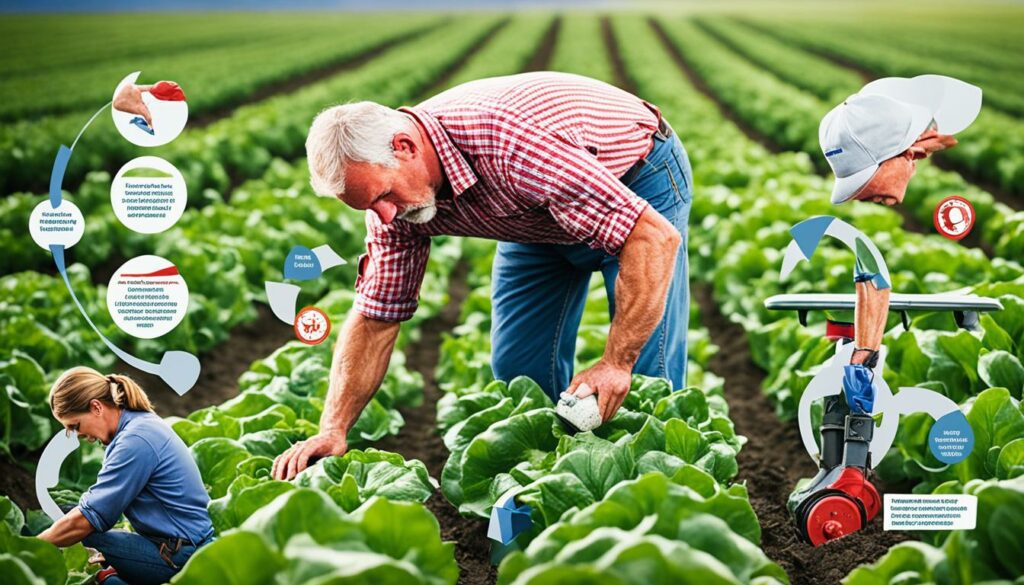
Common injuries in farming include sudden sprains and muscle strains. About a third of farm injuries that make people miss work are these. Back injuries are also common and account for a quarter of such cases. The tasks like lifting heavy stuff, bending, and standing too long make these injuries likely.
The long-term health effects for those in farming can be serious. Doing the same movements over and over can lead to carpal tunnel and tendonitis. For example, repetitive work like picking can increase this risk.
These health issues can greatly reduce how much work a person can do. This affects both their pay and how productive the farm is. In California, the cost of over 3,000 back injuries in agriculture can be more than $22 million per year.
Improving ergonomics is key for making farm workers healthier and safer. It cuts down on injuries and ups quality of life for those working in fields. This is important on many levels.
Ergonomic changes help with back pain, and issues in the shoulders, arms, and hands. A lot of farm workers struggle with these problems. They could be off work due to sprains, strains, and back issues, making up almost half of all work-related injuries.
In California, over 3,000 back injuries each year cost more than $22 million in workers’ comp. This shows how crucial it is to take action. Ergonomics can lower the risk of work injuries and help prevent the disability due to these disorders.
Changing how workers stand or move, using tools that fit better, and setting up work areas right are crucial. This includes getting the height of workstations and handles right. It also involves fitting vehicle seats with suspension to cut down on vibrations, making work safer and comfier.
Efforts that teach farm workers about ergonomics and offer support are vital. Groups like AgriSafe Network and AgrAbility provide valuable help. They offer advice and support to cope with the physical stress of farming.
By focusing on ergonomics and boosting rural health support, agriculture can become safer and more satisfying for its workers. This approach helps in various ways, like improving safety, lowering mental health issues, and increasing job happiness. It aims to build a farming community that’s healthy and strong.
Using ergonomic solutions in farming boosts productivity and lowers injury risks. This has several key benefits.
Ergonomic tools boost how quickly tasks get done on the farm. They are made to make work easier, reducing the strain on the body. This means workers don’t get as tired. They can keep working without needing as many breaks for their health.
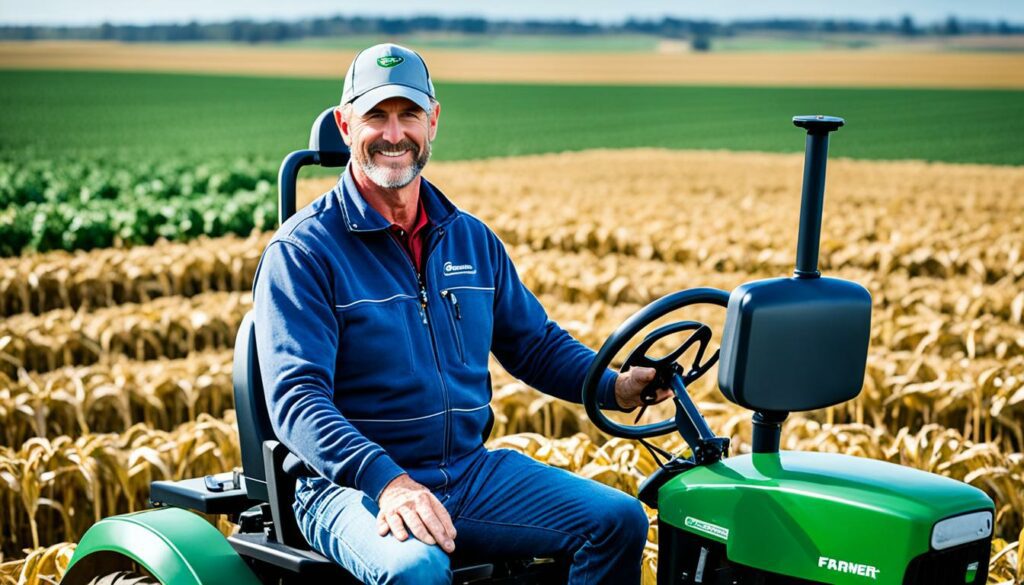
Ergonomic practices also cut down on injuries. Farm workers often face sprains, strains, and back problems. But, better postures and less force from ergonomic designs help avoid these issues.
For example, fixing the way work is done can save a lot of money. Every year in California, over 3,000 back injuries cost about $22 million in workers’ compensation. These costs and the people affected show the big win from using ergonomics. It reduces severe muscle and bone disorders from work too.
So, adding ergonomic designs to farming is a win-win. It makes work more efficient and keeps workers healthy. This investment improves the farm’s success and sustains the health of those working on it.
Improving safety and how much work gets done in farming starts with using ergonomic techniques. These methods help lower the chance of getting body aches from work and make sure tools suit the job.
Adding ergonomic know-how to farming jobs can kick-off with easy changes that make a big difference. Like, putting soft covers on tool handles makes them easy to hold. This stops hands from getting too tired. Changing the height of work areas can stop the need to bend over too much. Less bending means fewer back and shoulder problems for farm folks. Quick fixes, such as keeping tools close by and letting workers rest, cut down on overuse injuries.
For bigger improvements in ergonomics, it might be worth getting new gear. Lift-assist tools and machines that do the hard lifting for you cut down the risk of getting hurt. These items lower the amount of tough, hands-on work needed. Along with this, using programs that focus on ergonomics can tell you which jobs are tricky. They offer ways to make these tasks easier and safer. Programs like AgrAbility specifically help farmers solve their unique needs with ergonomic solutions, making the farm a safer place to work.
Ergonomic design is key in tools and equipment to cut physical stress and raise output when farming. Tools designed right lower pain and hardship for those who work the land. They can reduce backaches, arm, shoulder, and handache too.
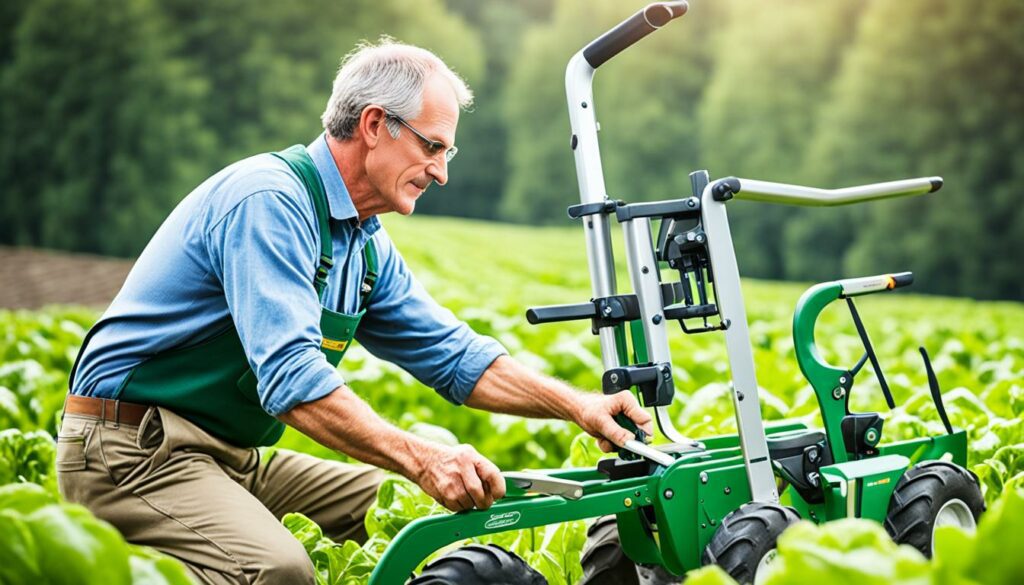
Tools made with the body’s natural movements in mind help keep away repetitive stress injuries. For example, using lightweight tools with soft grips stops blisters and cuts down tiredness in farmers. Properly designed tools also help avoid carpal tunnel syndrome, as Ferrante points out in 2016.
Using farming tools the right way is crucial. The National Institute for Occupational Safety and Health 2001 says work benches should match your hip height. They should also be close at hand, within 17 inches, to avoid strain. Keeping tools well and storing them right helps farm workers stay safe and keeps tools from failing.
By applying these principles in farming, issues like musculoskeletal disorders can drop. This lead to better health and work from farmers.
It’s vital for farmers to keep good posture in farming. This helps cut down on injuries. Many report backaches and arm pains. This is usually from bad posture and lifting the wrong way.
Having the right posture in farming lowers the stress on our bodies. When we use tools or work below shoulder height close to the body, it’s not as hard on us. Floor mats at standing workstations and having the right work heights can also help. They make us less tired and more comfortable.
Knowing how to lift correctly can stop a lot of injuries. Farmers should be told to lift using their legs, holding items close to them, and keeping their back straight. This way, they won’t lift things that are too heavy or high. Using tools to move items, like dollies, can also help avoid getting hurt.
Farm tools should have handles that are easy to hold. Their size should fit different hands. When tools have two handles, they should be just right for people to use with ease. This makes the work less tiring.
| Guidelines | Details |
|---|---|
| Tool Height | Below shoulder height, within 17 inches of worker’s body |
| Floor Mats Usage | Recommended for standing workstations to reduce fatigue |
| Lifting Guidelines | Keep lifts between hand and shoulder level, avoid floor or over shoulder lifts |
| Tool Handles | Should allow full grip, with diameters tailored to hand sizes |
These methods can help farmers handle their work better. By mixing heavy and light tasks and following safe practices, they can reduce the risk of injuries. This leads to a healthier and happier work life.
Many farms have seen big improvements from using ergonomic solutions. A 2016 study by the US Department of Labor showed that 30% of back injuries could’ve been avoided. This was through better workplace design and ergonomics. It proves the significant role of ergonomic solutions in health at work.
Deere and Company saw great results after an ergonomics training. They had 83% fewer back injuries and spending on healthcare went down 32% in ten years. A die cast manufacturing plant in Ohio also benefited greatly. After an ergonomic programme, they had 93% less in compensation costs, 67% less absent workers, and a 54% boost in their work output.
In Korea, a focus on peach farming discovered a lot of musculoskeletal disorders (MSDs). Back pain was a problem for almost half the farmers. After making changes, using the Rapid Upper-Limb Assessment (RULA) method, they found lower postural loads.
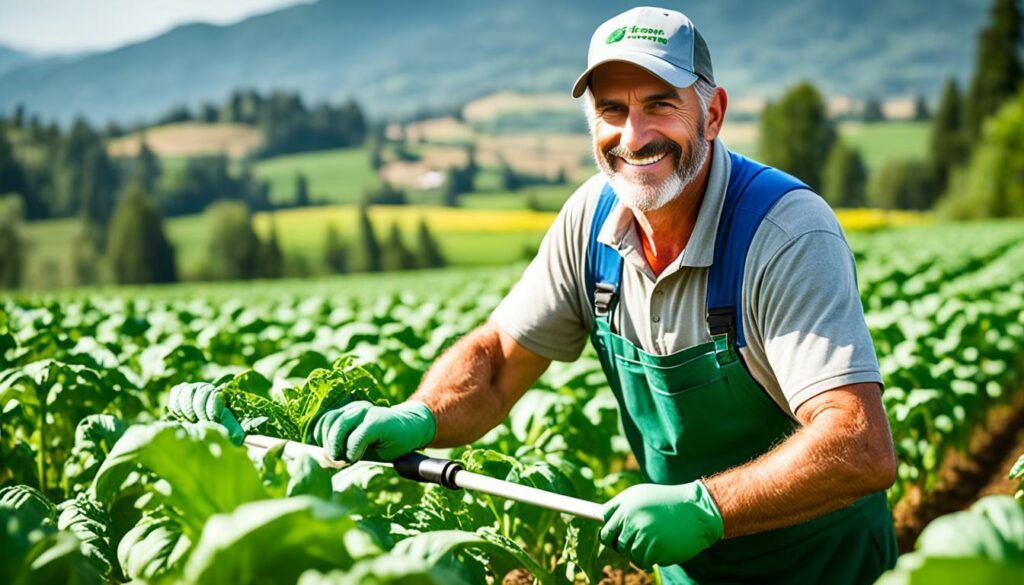
The table below shows success stories from farms that used ergonomic solutions:
| Company/Organisation | Ergonomic Intervention | Outcome |
|---|---|---|
| Deere and Company | Ergonomics Training Programme | 83% reduction in back injuries, 32% drop in healthcare compensation |
| Die Cast Manufacturing Plant (Ohio) | Full Ergonomics Programme | 93% drop in workers’ compensation costs, 67% decrease in absenteeism, 54% rise in productivity |
| Peach Farming in Korea | Ergonomic Task Analysis and Interventions | Reduction in MSDs, Improved postural loads |
These case studies in farming health highlight the benefits of using ergonomic solutions. They show how better ergonomics can make working conditions healthier. They also lead to improved productivity and a better overall quality of life for farmers. By following these success stories in agriculture ergonomics, other farms can introduce ergonomic practices and enjoy the benefits too.
Creating the right workstation for farmers is vital. It must focus on making work easier and safer. This includes making sure work surfaces are at the right height. This stops the need for bending too much or reaching too far. Tools and materials should be close by. This avoids moving a lot and reduces the risk of getting hurt.
An important step is looking at the health data of farmers. Adjusting the height of workspaces can cut down back and shoulder pain. Studies have shown that making tasks lighter and easier can reduce pain by up to 20%. This doesn’t affect how much work you can do.
Good workstations might have benches or tables that you can adjust. This is useful for sorting produce. It means you don’t have to stay in one position for too long, which can hurt your muscles. Also, using floor mats can help with tiredness from standing all day. A smart design lets farmers sit or stand as needed. This helps reduce the strains of working.
Take the Michigan AgrAbility project for example. They helped more than 200 farmers in 2023 by providing smart tools and changes. This kind of support makes a big difference for farmers who have a hard time working. It keeps them healthier and more productive for longer in the tough world of farming.
Assistive technology is changing how farmers work, making tasks easier and safer. There’s a wide range of tools and devices designed for the many challenges farmers face. These innovations are crucial for improving efficiency and decreasing injury risk.
A key part of assistive technology is the various devices farmers can use. From ergonomic shovels to high-tech lifts, there’s something for everyone. For instance, reducing weight in a tote bag by just 11 pounds can cut down pain significantly.
Need help choosing the right tool? Visit AgrAbility’s Assistive Technology page or the New Technologies for Ag Extension website. Since 2023, AgrAbility has been guiding over 200 clients yearly, helping them work better despite disabilities or limits.
Wearable tech is also changing farming. Exoskeletons and smart wearables are making heavy work safer. For example, exoskeletons help lift heavy items, protecting muscles and joints from harm.
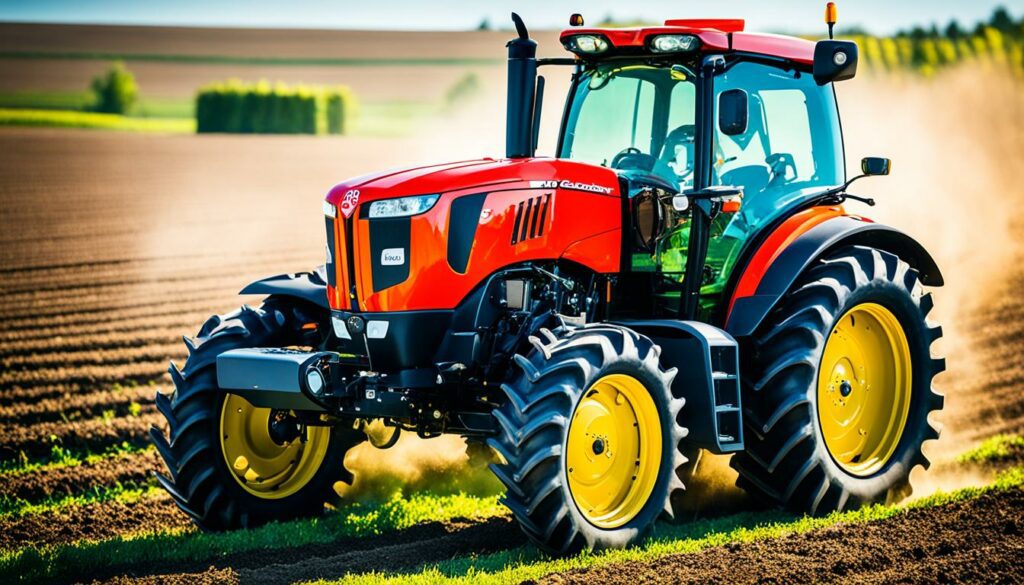
Mobile apps and digital platforms are improving health and safety. They collect data in real time, offering advice for safer work practices. Thanks to collaborations like CalAgrAbility and the Department of Rehabilitation, these tools are making a big difference in farmers’ lives.
Assistive technology is deeply impacting agriculture. It goes beyond aiding tasks to changing how we farm sustainably. It ensures the agricultural community is safer and more efficient.
Teaching farmers how to work without getting hurt is key. By showing farm workers the right ways to do things, they cut down on injuries and work better. This also helps lower the chances of getting hurt on the job.
Learning about ergonomics is very important for farmers. A lot of injuries that make workers stop working come from sprains and strains. Back injuries are also a big issue. These problems can keep people from working for a long time.
To work safer, farmers need to be shown how to avoid too much reaching, bending, or lifting. These can hurt their bodies. So, training is focused on making jobs easier on their bodies.
It’s great that there are many training resources for farmers. For example, Simple Solutions: Ergonomics for Farm Workers from NIOSH is a great start. It offers a wide range of materials.
These include hands-on and online training, as well as pamphlets and videos. They all teach farmers how to make their work safer. Using these resources can make a big difference without costing a lot.
Starting early intervention strategies is key to reducing health dangers for those working on farms. It’s all about tackling early signs of health issues. This helps stop major health problems later on. By acting fast, farm workers stay healthy and keep working well.
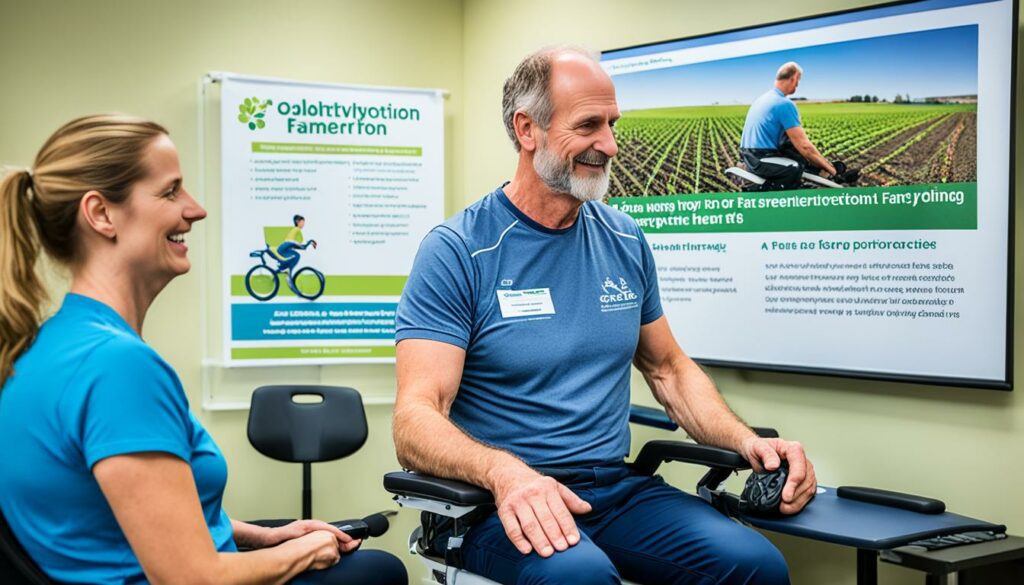
It’s vital to spot early signs like backaches and arm pain quickly. The National Institute for Occupational Safety and Health warned about this in 2001. Ferrante in 2016 pointed out the risks of carpal tunnel syndrome from long-term gripping. This shows why early intervention strategies are so crucial. By watching for these warnings, farmers can cut down the chances of serious health problems.
Preventing health issues in farming means adjusting work methods and using better tools. A study by Meyers and others in 2006 showed that lighter loads and totes with handles reduced pain. This helped by cutting down pain by one-fifth. They noted only a 2.5% loss in work rate. Also, the AgriSafe Network in 2024 confirmed that a simple floor mat can cut down on the tiredness from standing on hard floors.
Groups like AgrAbility are a huge help, working with more than 200 people facing challenges in 2023. They provide tech advice and tech solutions. This support keeps farms running smoothly while protecting workers’ health.
| Strategy | Outcome | Statistics |
|---|---|---|
| Reduction of Load Weight | Reduced Pain | Up to 20% improvement (Meyers et al., 2006) |
| Use of Floor Mats | Less Fatigue | AgriSafe Network, 2024 |
| Assistive Technologies | Enhanced Productivity | Over 200 clients served (AgrAbility, 2023) |
Introducing these early strategies and health prevention methods is essential for farm workers’ health and the farm’s success. By acting early, we can stop many health issues and better how farms work.
Farmers often suffer from backaches and shoulder pain due to their work. The physical demands of farming can make these issues worse. So, there are farmer health initiatives to help out. They aim to connect farmers with community support in agriculture. This helps them deal with health risks and improve their well-being.
Efforts centred around ergonomic improvements can significantly reduce work-related injuries and costs, such as the estimated $22 million annually spent on workers’ compensation for back injuries in California agriculture alone.
Many groups are working together on farmer health initiatives. This includes agricultural groups, health experts, and local communities. They want to provide farmers with helpful information and health services. Teaching farmers about good ergonomic practices is key. It makes their work safer and more efficient.
Work-related musculoskeletal disorders (WMSDs) are a big issue for working people. They’re also a major concern in farming. By promoting community support in agriculture, we can help farmers avoid these injuries. This includes changing how they work to better their posture and reduce strain.
These initiatives also look at making tools and work setup more ergonomic. This helps jobs match up better with what farmers can safely do. It boosts safety, comfort, and how well they work. So, community health initiatives focus on preventing injuries and building a healthier, longer-lasting farming community.
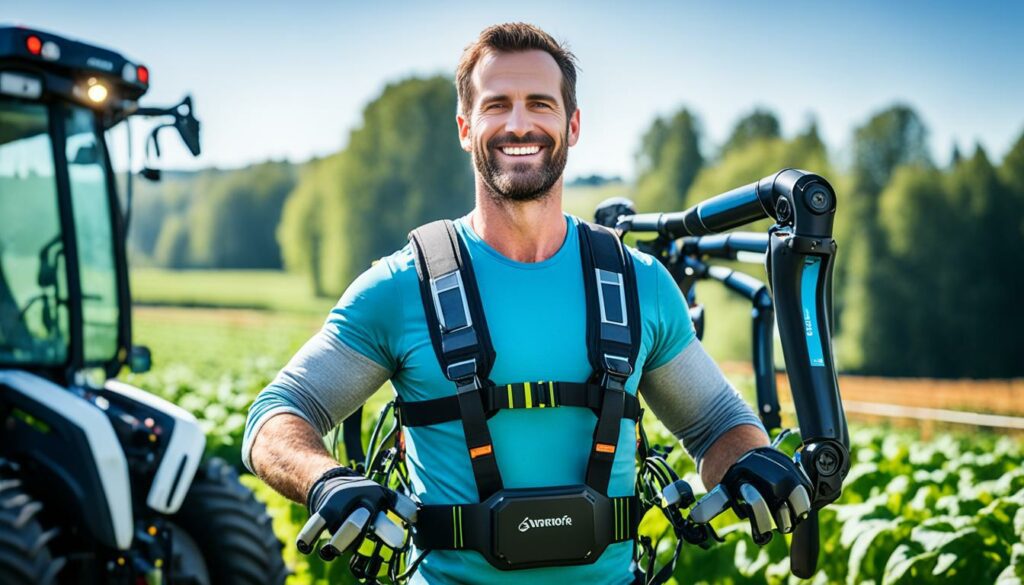
The future of farming looks bright with new trends. Researchers are looking at using many sensors, like 3D laser scanners and thermal cameras. These sensors make farm machines work better in different areas.
Recent studies focus on making farm work easier. They are creating machines that can work on their own. This helps farmers avoid getting tired. Also, they use special devices that follow how the body moves. This helps reduce body strains.
New technology in farming does a lot to keep farmers healthy and work better. For example, at the University of Illinois, they’re setting safety rules for machines that work alone. These steps are important. They make sure farm machines can see and avoid things when they work.
| Factor | Details |
|---|---|
| Research Papers Reviewed | More than 60 academic papers |
| Focus Areas | Environmental perception, risk assessment techniques, human factors, ergonomics |
| Types of Sensors | 3D laser scanners, ultrasonic sensors, remote sensing, stereo vision, thermal cameras |
| Safety Standards | Revised standards needed for autonomous systems |
| State Regulations | California, Indiana have additional regulations |
Farming is starting to use high-tech sensors more. This makes farming both better and safer. It means less hard work for farmers too.
Ergonomics is key for farmers’ health and well-being. In agriculture, which ranks high for work-related injuries, ergonomics is crucial. It aims to lessen risks and improve working conditions. This is vital because many farmers face musculoskeletal disorders (MSDs). These include issues like low back pain due to repetitive movements.
Using the wrong tools or methods can lead to health problems. For example, bending the knee a lot can cause knee and hip issues. Ergonomic technology is starting to help, though. An example is using smaller tubs for gathering grapes to lessen pain. Research from 2010 to 2019 shows how much this can help reduce MSDs in farming.
Using ergonomics helps keep farmers healthy. It also makes farming more sustainable. By supporting ergonomic studies and tools, we improve farming’s future. This affects both the health and career satisfaction of those in farming. So, investing in ergonomics has many benefits, including for future farming practices.
Ergonomics is key for farmer health. It lessens the strain from hard work. It helps avoid injuries and boosts how much work gets done. This way, farmers can work for a long time without getting tired.
Ergonomics focuses on making the farm fit the workers. It aims to keep farmers safe while they work. By making things easier, it stops workers from getting hurt.
Ergonomic problems on farms include injuries from doing the same movements a lot. Also, using tools and workspaces that are not well-designed leads to bad posture and sore muscles.
Farm workers often get hurt in their backs, shoulders, and hands. These injuries can be small, like a sprain, or long-lasting, like carpal tunnel. They’re from doing tough tasks repeatedly.
Farm work that needs a lot of effort can lead to serious health issues. These might mean less money for the worker or the farm. It can also make things hard to keep going on the farm.
Better working setups mean fewer injuries and less stress. This makes workers happier with their jobs. So, making the job easier is good for everyone’s health.
Working smarter usually means getting more done. By using tools that are right for the body, work is not as hard. This means fewer breaks for sore muscles and bones.
There are easy ways to make work less hard on the body. Adding cushioning to tool handles helps your grip. Making sure you don’t have to bend or stretch too much is important too.
More high-tech solutions include machines that do the heavy lifting. These let workers use less muscle power. This way, the chance of getting hurt goes down.
Good tools can stop injuries caused by doing the same task over and over. Tools designed for the job mean less pain and a job that’s easier to do.
Using tools the right way stops health problems from getting worse. This means holding tools right and keeping them in good shape. Doing so keeps your hands and arms from being too sore.
How you stand and lift things makes a big difference in staying safe. Lifting with the legs keeps your back from getting hurt. It’s all about making sure you do things in a way that protects your body.
Lifting right is a big step towards not hurting yourself. Bend your knees and keep the load close to you. This way, your back doesn’t have to do all the hard work.
There are things like potting stands that are made to be just right. They stop the need to reach too far. Or benches that adjust high, helping to work better without moving too much. These changes make a big difference in staying healthy.
When making a good work space, think about how high things are. Stuff should be easy to reach. Using tables that can change height is one good idea. Then, you can make sure you work without hurting your back.
Assistive tech makes work lighter and safer. Wearable gadgets and apps help keep an eye on how you’re doing. They make sure you stay healthy as you work.
Knowing the right way to work means less chance of getting hurt. Training and good info help farmers use ergonomic tools and set up safe spaces. These basics are a great start for working the right way.
Start by looking for health risks before they get bad. Change how things are done, use the right tools, and do exercises that help. These steps are a good way to make sure you keep well while working.
Community projects bring farmers together and teach them about staying healthy. They share tips, offer services, and help get tech that makes work easier. They are all about helping everyone live better as they farm.
Future ideas include machines that work more on their own. Also, clothes that check how you move, making sure you don’t get too tired. These new things aim to make farming less hard on the body.